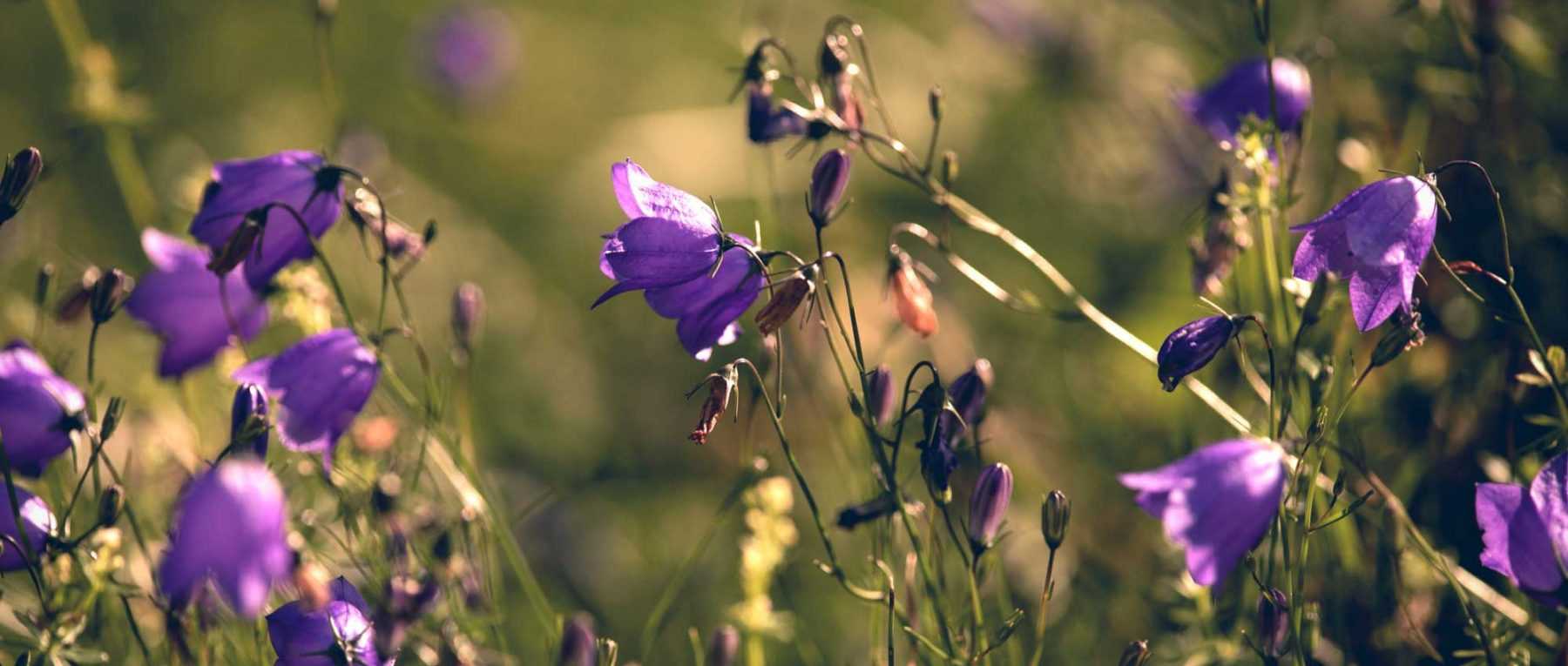
Bellflowers: Planting, Growing and Care
Contents
The bellflower in a few words
- The bellflower charms with its abundant bell-shaped blooms, often in blue-mauve hues!
- It produces very delicate flowers, either bell-shaped or star-shaped
- The different species boast highly varied forms: they can be trailing, carpeting, or upright
- In the garden, they suit almost all uses: in rockeries, on walls, in perennial borders, in pots or containers, in woodland gardens, etc.
- It’s an easy-to-grow plant, perfect for beginners
Our Expert's Word
Bellflowers are often perennial plants that offer abundant and long-lasting blooms! We mostly know bellflowers for their blue or mauve flowers, but they can also be white or pink depending on the variety. With their delicate, nodding bell-shaped flowers, bellflowers have a fragile and touching charm… Their blooms may be simple, but they are undeniably enchanting! Bellflowers can grow very tall (up to 2m), with an upright habit and spiked flowers, or they can be ground-covering, forming cushions smothered in blooms, like the wall bellflower or the Carpathian bellflower.
Their use in the garden is highly versatile: taller varieties like Campanula persicifolia or Campanula glomerata are perfect for flower beds, while smaller types such as Campanula portenschlagiana or carpatica are better suited to rockeries or low walls. Others are ideal for borders, woodland gardens, or window boxes… Bellflowers are incredibly adaptable, fitting a wide range of gardening needs!
Bellflowers are very easy to grow. Undemanding, they require minimal maintenance (or even none at all, as with Campanula muralis). We recommend planting them in full sun or partial shade, in well-drained and light soil. They can be easily propagated by seed, division, or cuttings… and sometimes even self-seed!
Description and botany
Botanical data
- Latin name Campanula sp.
- Family Campanulaceae
- Common name Bellflower
- Flowering spring or summer
- Height highly variable, between 5 cm and 2 m
- Sun exposure sun or partial shade
- Soil type well-drained, rocky, even dry for ground-covering bellflowers; fertile and moist for taller varieties
- Hardiness down to –20°C for most varieties
The bellflower is a perennial, annual, or biennial plant native to temperate regions of the Northern Hemisphere, which explains its excellent hardiness. There are over 400 species! They can be found particularly in the Alps and around the Mediterranean, where they grow in diverse habitats: in light woodlands, meadows, along paths, on rocky slopes, and sometimes even on walls… In France, around thirty species can be encountered in the wild. Most cultivated bellflowers are perennials, though some are biennials, like Campanula medium, or annuals, such as Campanula macrostyla, though these are far less common. Despite their delicate and fragile appearance, bellflowers are actually quite robust plants. Most are fully hardy.
Its Latin name, Campanula, means little bell, or small bell. It refers, of course, to the shape of the flowers. The term “campanulate” has even been retained to describe flowers resembling the bell-like shape of the bellflower.
The bellflower belongs to the Campanulaceae family, which takes its name from the genus. This family includes around 2,400 species, such as Phyteuma (rampion), Platycodon, Lobelia, Brighamia (a houseplant also known as the Hawaiian Palm), or Legousia (like the Venus’ Looking Glass, which grows wild in France)… Within the Campanulaceae, some genera are very close to bellflowers, with flowers that closely resemble them: Adenophora, Canarina, Platycodon… The latter, Platycodons, are beautiful ornamental plants, sometimes grown in gardens, bearing large star-shaped blue flowers.
Bellflowers exhibit highly variable growth habits and appearances depending on the species! Some form carpets, while others cascade or stand upright with erect stems. These plants grow relatively quickly. Bellflowers have a rather flexible, light, and airy structure, with slender, elongated stems. Their tissues often contain latex.
Bellflowers range from 5-10 cm for the smallest to 1.50 m for the tallest… And even up to 2 metres or more for Campanula pyramidalis! Their uses will therefore vary greatly depending on their habit and height. Taller varieties, like Campanula pyramidalis or Campanula persicifolia, are perfect for borders, while ground-covering species (Campanula poscharskyana, Campanula muralis…) are better suited to walls or rockeries. Some bellflowers can even be grown in containers!
Bellflowers bloom in spring or summer, between May and September-October, depending on the variety. Their flowering period is long: often at least three months, sometimes up to six! Moreover, their blooms are abundant—sometimes plants are literally covered in flowers, hiding their foliage (Campanula muralis…)!
The flowers are usually clustered in upright spikes or racemes at the stem tips, but they can also be solitary. They are densely grouped, like a bouquet, in Campanula glomerata.
The flowers come in a beautiful range of blue-violet hues, but they can also be white. White-flowered varieties are easily identified, as they are usually named ‘Alba’ (= white in Latin): Campanula persicifolia ‘Alba’, Campanula carpatica ‘Alba’, etc. There are also species with pink flowers (Campanula takesimana ‘Elisabeth’ or Campanula ‘Ringsabell Mulberry Rose’). A few species have yellow flowers, like Campanula sulphurea, though these are much rarer. The flowers are usually a solid colour, reinforcing the very “simple” (humble, unpretentious) nature of the bellflower. In Campanula ‘Iridescent Bells’, the pale mauve-silver bells contrast with deep purple flower buds. The inside of Campanula punctata flowers is speckled with red or pink dots!
The flowers can be bell-shaped, tubular, or star-shaped. They are very regular, with radial symmetry. They consist of petals fused into a bell or tube, ending in five lobes (corresponding to each petal). These bells are surrounded by the calyx (sepals), which also forms five lobes. The flowers are hermaphroditic: they contain both female (pistil) and male (stamen) organs. Thus, at the centre of the flower, there are five stamens and a pistil… But they mature at different times to avoid self-fertilisation. The inside of the corolla is hairy in Campanula barbata!
When the corolla is very open and deeply divided into five lobes, the flower takes on a true star shape, as in Campanula garganica. Conversely, the tube can be very elongated and narrow, barely lobed (Campanula takesimana…). Sometimes, the flowers are cup-shaped, with a rounded form. The flowers are very unusual in the variety ‘Pink Octopus’: with very thin, deeply cut petals resembling octopus tentacles!
There are also a few double-flowered varieties, such as Campanula cochlearifolia ‘Elizabeth Oliver’ or Campanula trachelium ‘Bernice’. They have a very romantic and sophisticated, refined appearance. Similarly, Campanula haylodgensis varieties usually have double flowers!
Bellflower blooms are often nodding, facing downward. This gives them a very humble appearance. But some species have flowers that face upward or horizontally.


Bellflower blooms can take quite varied forms! Campanula persicifolia ‘La Belle’ (photo Takashi M), Campanula garganica (photo Meneerke bloem), Campanula ‘Ringsabell Mulberry Rose’ and Campanula glomerata ‘Caroline’
Depending on the variety, bellflower leaves can be oval, oblong, or cordate (heart-shaped). They are simple, entire (not divided into leaflets), and sometimes pubescent. The leaves are alternate, arranged one after another along the stem. The leaf margins are often toothed but can also be smooth. Bellflowers can be evergreen, semi-evergreen, or deciduous.
Leaf size varies greatly. They are generally quite small in creeping, rockery species (Campanula portenschlagiana, poscharskyana, carpatica…): between 1 and 5 cm long; while they are larger in upright perennials: often between 7 and 15 cm in length.
Leaf shape can also vary significantly on the same plant. Basal leaves are usually larger and broader, while those higher up the stem are often smaller and narrower. Some species are named after their leaf shape: Campanula persicifolia = peach-leaved; Campanula rotundifolia = round-leaved; Campanula latifolia = broad-leaved; Campanula cochleariifolia = spoon-leaved; etc. This makes them easier to distinguish.
Though most species have green leaves, Campanula garganica ‘Dickson’s Gold’ bears lovely golden foliage, extremely bright!


Leaves of various bellflowers: Campanula rapunculoides (photo Hectonichus), Campanula latifolia (photo Salicyna) and Campanula portenschlagiana (photo Salicyna)
After flowering, the bellflower produces a capsule that opens when ripe, releasing numerous small seeds. Bellflowers can self-seed readily!
The main varieties of bellflowers
These bellflowers feature erect stems and often spiked flowers. Some can grow very tall (up to 1.50 m or even 2 m for Campanula pyramidalis). They thrive in rich, fertile, light, well-drained but relatively moist soil.
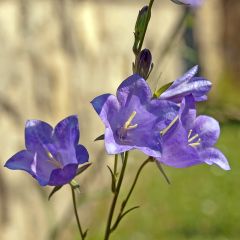
Campanula persicifolia
- Flowering time July to September
- Height at maturity 80 cm
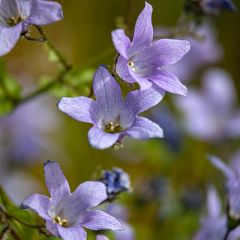
Campanula lactiflora Prichards variety
- Flowering time August, September
- Height at maturity 1 m
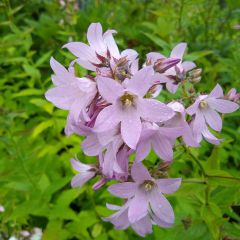
Campanula lactiflora Loddon Anna
- Flowering time August, September
- Height at maturity 1 m
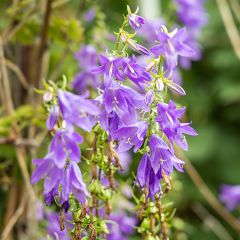
Campanula trachelium
- Flowering time July to September
- Height at maturity 75 cm
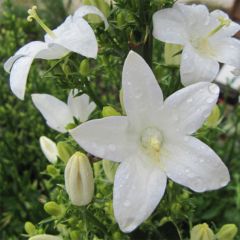
Campanula pyramidalis Alba
- Flowering time July to September
- Height at maturity 1 m

Campanula takesimana Elizabeth
- Flowering time July to September
- Height at maturity 40 cm
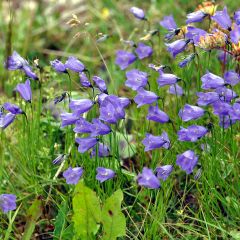
Campanula rotundifolia
- Flowering time July to November
- Height at maturity 30 cm
These species thrive in well-drained, even dry soil: they are perfect for rockeries, between paving stones, in the cracks of dry stone walls, in containers on sunny terraces, or sometimes simply as border plants. They have a cushion-forming or spreading habit, and depending on the variety, can be completely covered in flowers!
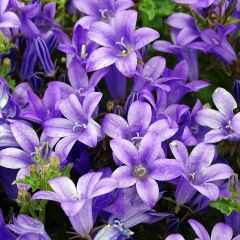
Campanula portenschlagiana
- Flowering time July to October
- Height at maturity 20 cm
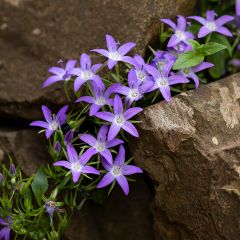
Campanula poscharskyana
- Flowering time June to October
- Height at maturity 30 cm
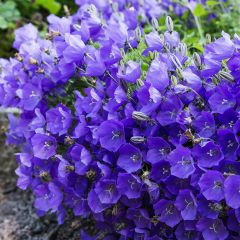
Campanula carpatica
- Flowering time July to September
- Height at maturity 25 cm
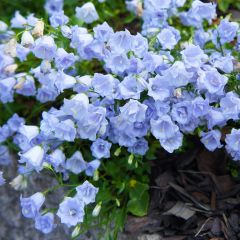
Campanula cochlearifolia Elizabeth Oliver
- Flowering time July to September
- Height at maturity 15 cm
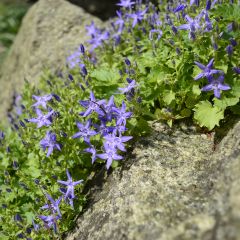
Campanula garganica
- Flowering time July, August
- Height at maturity 15 cm
Discover other Campanula - Bell Flower
Planting
Where to plant bellflowers?
Plant bellflowers in full sun or partial shade. Flowering is often more abundant in sunny spots, but full sun may cause the blooms to fade – they’ll display richer hues in dappled shade! Avoid scorching sunlight. Campanula latifolia is one of the best varieties for shady locations.
Bellflowers are fairly undemanding regarding soil type. We recommend planting them in well-drained ground as they dislike waterlogged conditions. The ideal planting location will differ depending on whether you’re growing tall upright varieties or compact alpine bellflowers.
For taller varieties, position them in borders with fertile, well-drained yet moisture-retentive soil that’s light and humus-rich. As these plants grow quite tall, shelter them from strong winds. Campanula lactiflora particularly thrives in rich soils.
Low-growing, mat-forming bellflowers are perfect for rockeries, stone walls, between paving stones, or along border edges. They prefer sharply drained, relatively dry ground and can thrive in shallow soil with minimal nutrients.
Moderately compact varieties like Campanula poscharskyana also adapt well to container cultivation in pots or window boxes.
When to plant?
The optimal planting time is autumn, around October, though spring planting also works well. Annual species can be direct-sown in spring.
How to plant?
Allow about 25cm spacing for compact varieties, 35-40cm for taller types, and 40-50cm for large Campanula lactiflora specimens.
- Soak the rootball in a water-filled basin.
- Dig a planting hole. For rockery species, improve drainage by mixing in coarse sand, gravel or volcanic rock.
- Position the plant with the crown level with the soil surface (avoid burying it).
- Backfill and firm the soil gently.
- Water thoroughly.
- Apply mulch if desired.
You can also grow bellflowers in containers or window boxes.
Campanula Care
Bellflowers generally require very little maintenance. Any necessary tasks are quite basic… Easy-going, this is a low-maintenance plant!
Remove faded flowers, both for aesthetic reasons and to prolong flowering (this encourages new blooms). Similarly, once flowering has finished, it’s sometimes preferable to prune the stems to encourage a second flush of flowers and promote bushier growth.
Bellflowers can usually do without watering (especially ground-covering and rockery varieties). However, we recommend watering during prolonged dry spells. Likewise, in the weeks following planting, it’s best to water occasionally until the plant is well established. Don’t hesitate to apply mulch around your bellflowers to help the soil retain moisture.
Taller species may require staking (Campanula pyramidalis, etc.). Similarly, the flower spikes of Campanula takesimana sometimes tend to flop in rainy weather. You may need to support them with stakes.
You can add well-rotted compost in spring. This will encourage abundant flowering.
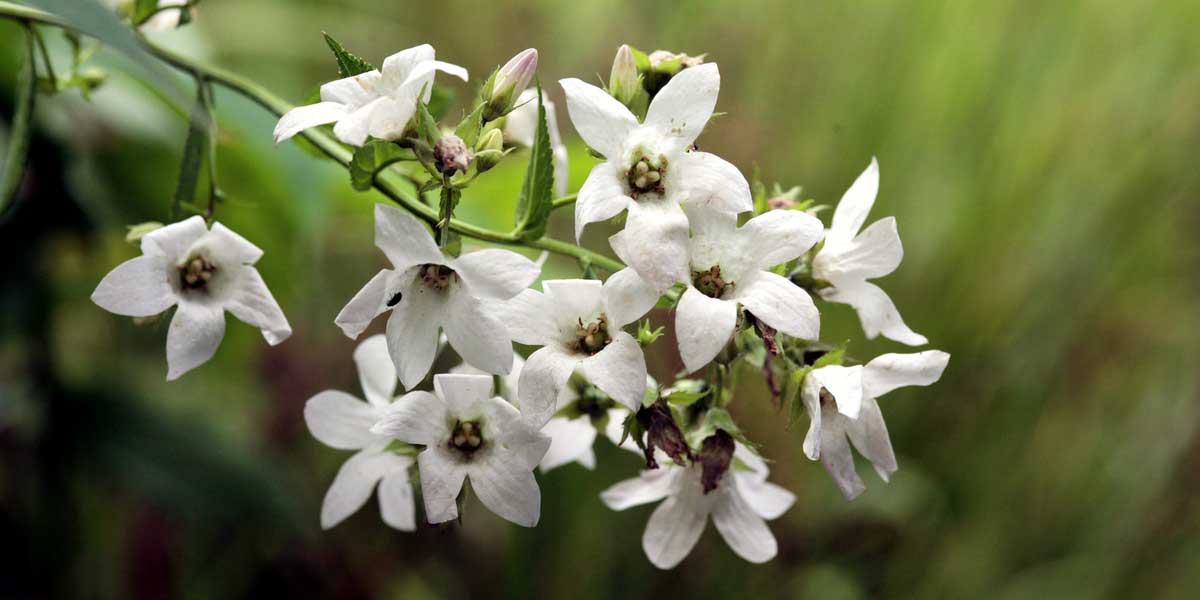
Campanula lactiflora ‘Alba’
Diseases and pests
Regarding pests, it sometimes happens that slugs and snails nibble on bellflowers! To protect your young plants, you can create a slug trap. They may also be affected by froghoppers, small insects that pierce the plant’s tissues to extract sap. They can be identified by the presence of a white foam, resembling spit, on the plant’s stems. Apart from being unsightly, the damage is relatively minor. Bellflowers are also occasionally attacked by vine weevils, a beetle whose larvae chew on the roots while the adults consume the foliage.
Some species of bellflowers can be affected by rust. This is caused by Coleosporium campanulae, a fungal disease identified by rust-coloured spots on the leaves. Larger varieties seem most susceptible, particularly Campanula persicifolia or Campanula latifolia. Since this disease thrives in damp conditions, we recommend avoiding overwatering your bellflowers and keeping the foliage dry. Bellflowers are also prone to powdery mildew. This fungal disease appears as a white, powdery coating on the leaves. To combat both diseases, we suggest removing affected leaves and spraying with a sulphur-based solution or horsetail decoction. Finally, some bellflowers are susceptible to sclerotinia, also known as “white mould.” If detected, it’s best to remove and dispose of infected plants.
Propagation: sowing, division, cuttings
You can propagate bellflowers by sowing or division, and even by cuttings. They may tend to self-seed, especially if you leave the faded flowers in place!
Sowing
Sow bellflowers in spring, from April to June. Annual species can be sown directly in place, while perennials and biennials can be sown under a cold frame (or directly in the ground if you live in a mild climate).
If you grow different horticultural varieties, especially those with differently coloured blooms, we recommend division or cuttings instead, to ensure you get an identical new plant.
To sow bellflowers in pots:
- Prepare a pot by filling it with seed compost.
- Sow the seeds.
- Cover them with a very thin layer of substrate.
- Water gently with a fine spray.
- Place the pot in a bright spot, as the seeds need light to germinate. We recommend placing them under a cold frame. Keep the substrate slightly moist until germination.
- Transplant the young seedlings once they are large enough to handle. You can then start spacing out watering.
- Plant them in their final position in early autumn (September-October).
To sow directly in the ground:
- Prepare the soil by breaking up large clumps and adding some compost. If drainage needs improving, mix in some coarse sand.
- Sow (broadcast or in shallow furrows).
- Cover with a light layer of compost.
- Water gently with a fine spray.
- Continue watering regularly until germination.
- You can then space out watering and thin the seedlings, keeping only the strongest ones.
Division
You can propagate bellflowers by division in early spring, when new shoots begin to appear. However, it can also be done in autumn, around October, once flowering has finished. Ground-covering species are the easiest to divide! You can divide your bellflowers every three years.
- Choose a well-developed clump, then dig around it carefully to lift it without damaging the roots.
- Divide it into several sections by hand or with a knife, ensuring each has enough roots.
- Replant in another location.
- Water generously.
Cuttings
You can take cuttings from bellflowers in spring or early summer.
- Fill a pot with compost, firm lightly, then water to moisten.
- Take a stem cutting from the base of the plant, about 5 cm long.
- Remove any lower leaves, keeping only a few at the top.
- Optionally dip the stem in rooting hormone.
- Make a small hole in the compost with a stick or pencil, then insert your cutting.
- Firm the compost around it to ensure good contact and avoid air pockets.
- Place the cutting under a cold frame, away from direct sunlight. Keep the compost slightly moist.
Pairing Campanulas in the Garden
The tallest bellflowers (Campanula pyramidalis, Campanula lactiflora, etc.) are perfect for adding to a colourful flowerbed alongside other perennials! Plant them towards the back of the border and create a ‘cottage garden’ feel by pairing them with other blue or white flowering plants. Combine them with foxgloves, lupins, poppies, alliums, hardy geraniums… Enjoy the airy blooms of baby’s breath too! Finally, with their delicate, graceful flowers, bellflowers also pair beautifully with roses!
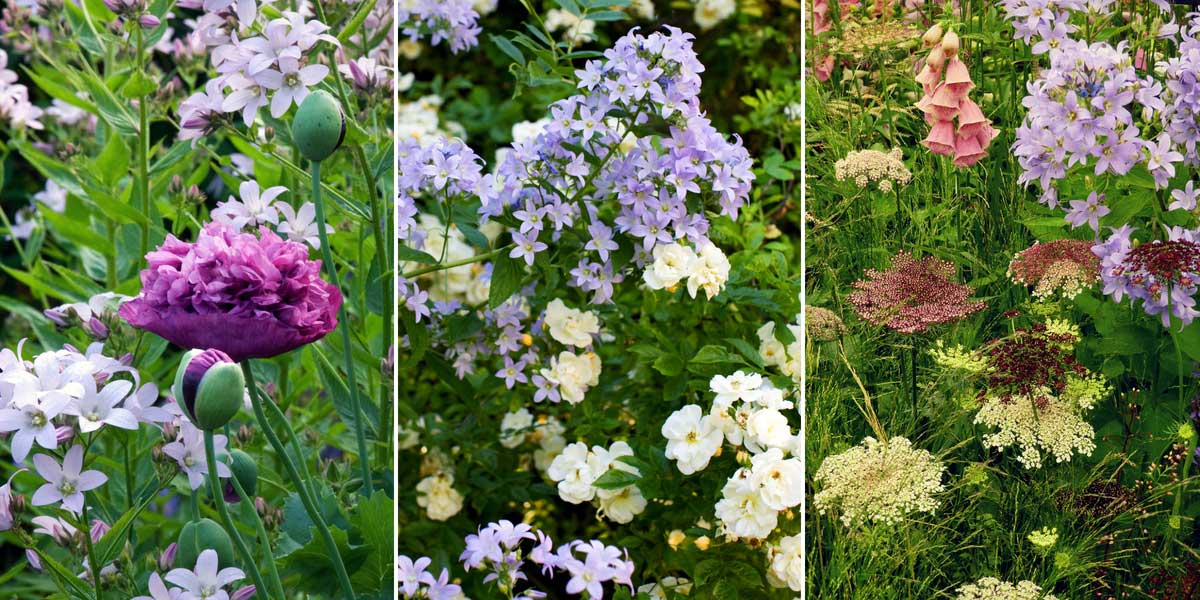

Campanula ‘Loddon Anna’ and Papaver ‘Purple Peony’ (photo Fiona Lea – GAP) / Campanula lactiflora and Rosa ‘Opalia’ (photo Pernilla Bergdahl – GAP) / Daucus carota ‘Dara’, Digitalis and Campanula lactiflora
As bellflowers have a rather natural look, they can easily find a place in a woodland garden. Choose, for example, Campanula trachelium or Campanula latifolia, two species sometimes found growing wild in forests. Plant them alongside ferns, columbines, brunneras or toad lilies.
Bellflowers also suit a naturalistic, meadow-style garden. Pair Campanula rotundifolia with the airy foliage of ornamental grasses (Pennisetum, Stipa…), and add a few flowering plants: cornflowers and other knapweeds, poppies, scabious, blue vervain (Verbena hastata)…
Thanks to their flexible stems and delicate blooms, bellflowers create contrasting shapes and add lightness to a highly structured border. If your garden has a modern style with clean lines and neatly trimmed plants, you can introduce a few bellflowers here and there (Campanula rotundifolia, Campanula trachelium or Campanula alliariifolia) to create contrast by softening the look with movement and grace!
The low-growing, carpeting bellflowers (Campanula muralis, Campanula poscharskyana, Campanula carpatica…) are ideal for planting on a dry-stone wall or in a rockery, alongside saxifrages, phlox, houseleeks or aubrietas… Bellflowers will bring vibrant colour to the rockery with their long-lasting blooms, requiring very little maintenance!
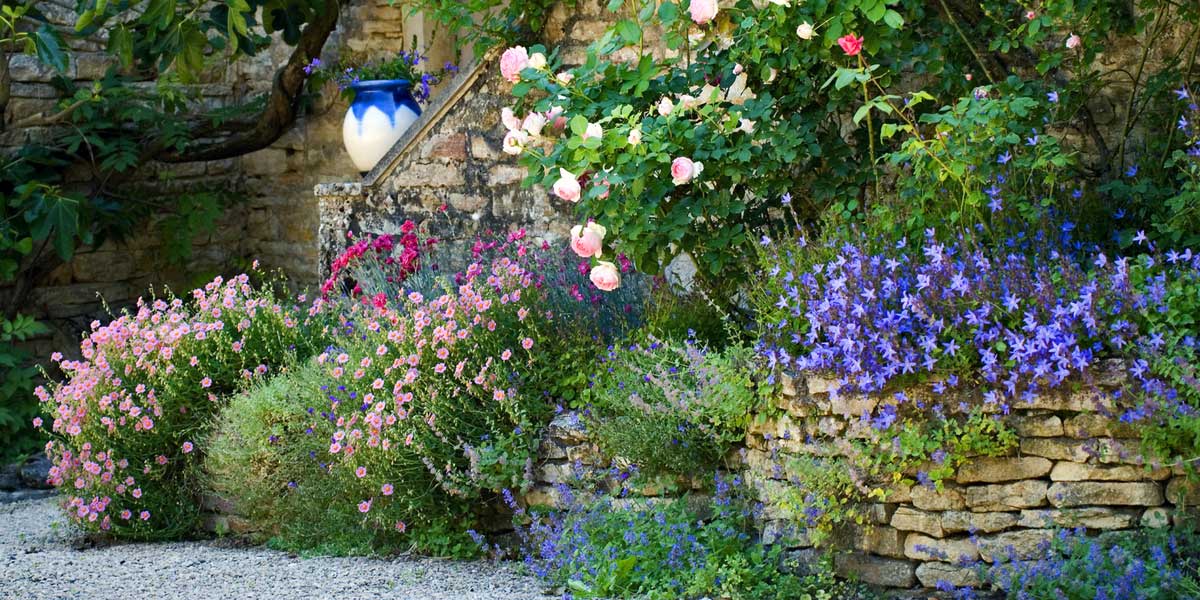

Create a striking rock garden scene by combining a rockery bellflower with Rosa ‘Pierre de Ronsard’, Helianthemum ‘Lawrenson’s Pink’, Nepeta racemosa ‘Grog’ and Dianthus ‘Romeo’ (photo E. Gonnet – Biosphoto)
The creeping varieties also make lovely, colourful edging! You could plant a perennial border and, along the edge—perhaps spilling slightly onto a path or paving—add Campanula muralis all around to create a ‘belt’ of blue-violet flowers…
Finally, if you’re short on space or simply want to brighten up your patio, windowsill or balcony, you can grow small bellflowers in pots or containers. Try planting Campanula poscharskyana with carex, Muehlenbeckia, agathea, love-in-a-mist…
→ Discover more bellflower pairing ideas in our guide
Did you know?
- An edible bellflower!
Rampion bellflower, Campanula rapunculus, is a biennial plant that was once commonly cultivated in Europe as a vegetable. The leaves can be eaten in salads, while the roots may be consumed raw or boiled. The flowers can also be used to decorate dishes.
Useful resources
- Discover our range of bellflowers!
- Our bellflower seeds!
- An interesting article about bellflower blooms
- Our advice sheets: 6 blue-violet flowering bellflowers, pink flowering bellflowers, 6 white bellflowers
- Our advice sheets: 7 tall bellflowers for the back of borders, 6 bellflowers for edging, 6 groundcover bellflowers
- Our advice sheets: Bellflowers with bell-shaped blooms, 7 star-shaped flowering bellflowers
- Our advice sheet: Combining bellflowers
- Our advice sheet: Growing bellflowers in pots
- Our advice sheet: The most beautiful bellflowers
Frequently asked questions
-
The leaves of my campanula have yellow or rust-coloured spots! What should I do?
This fungal disease is aptly named as it is rust, specifically Coleosporium campanulae, a fungus noticeable by the appearance of yellow or orange spots on the upper surface of leaves and small, powdery rust-coloured pustules on the underside. To counter the progression of the disease, cut off and burn the affected parts, then spray the foliage with a sulphur-based solution or a horsetail decoction.
-
The leaves of my campanula appear cut, eaten away!
This is likely due to slugs and snails, which enjoy nibbling on campanula foliage. You could set up a beer trap. It could also be caused by caterpillars.
-
Can I grow bellflowers in pots?
Bellflowers are undemanding plants that can easily be grown in pots or containers, though we recommend choosing the most compact varieties, such as Campanula poscharskyana.
- Subscribe!
- Contents
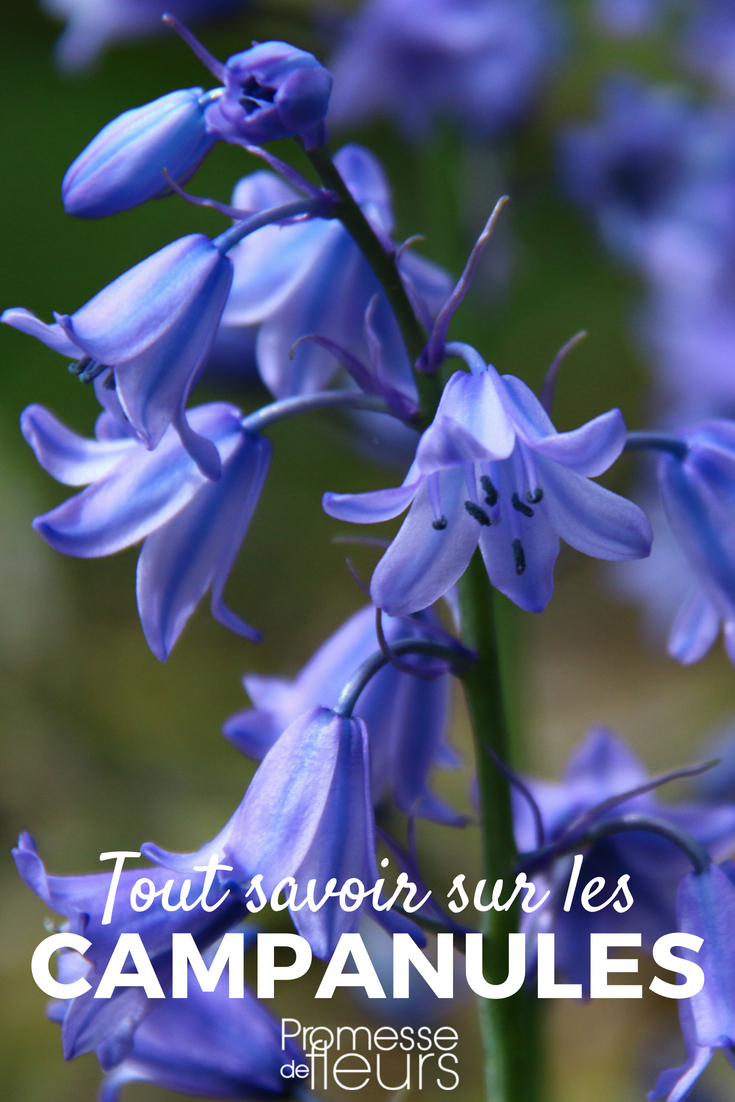


































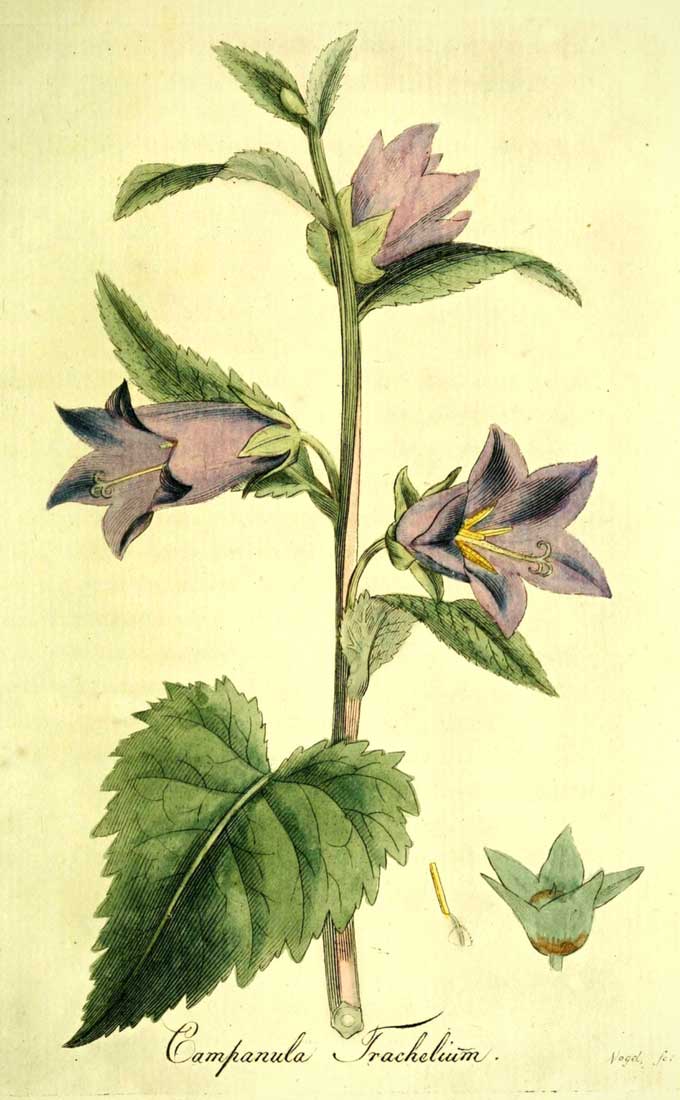
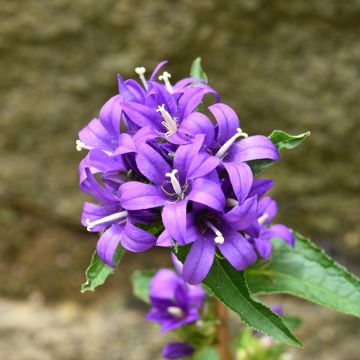

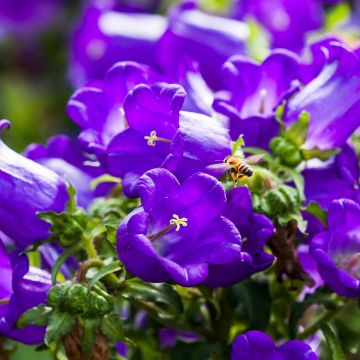

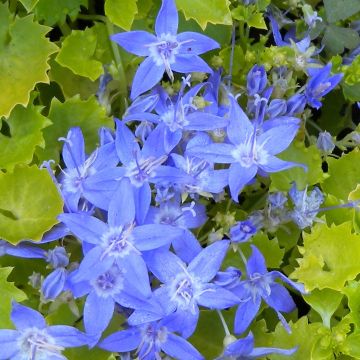
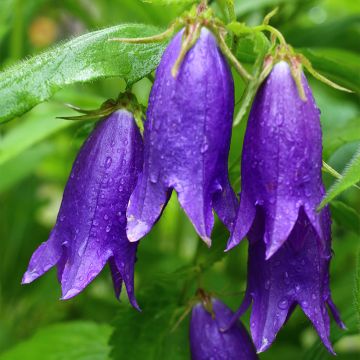
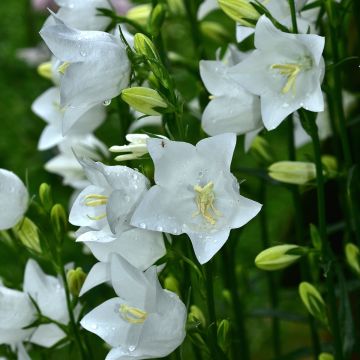
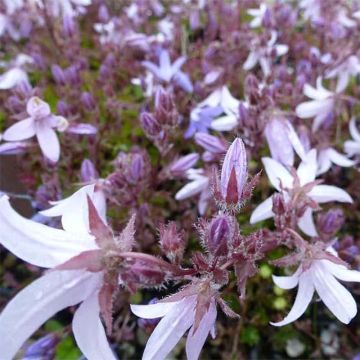
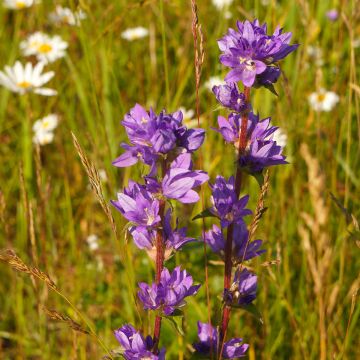
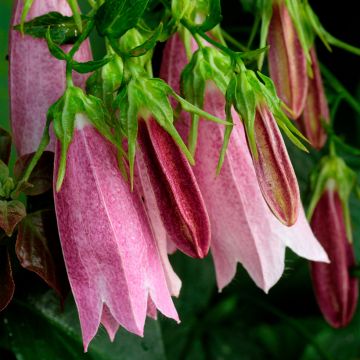
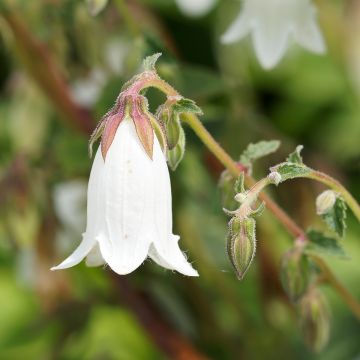

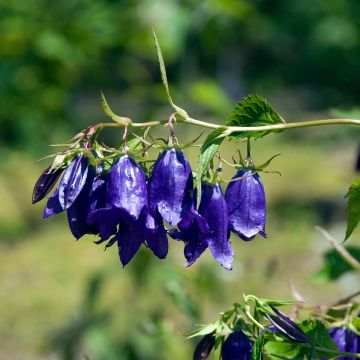
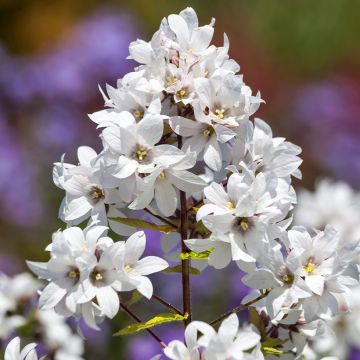
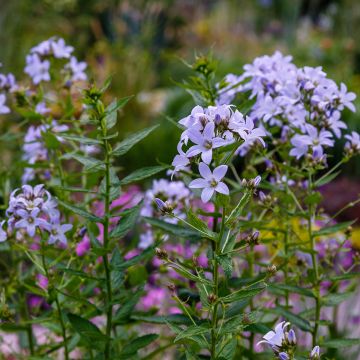
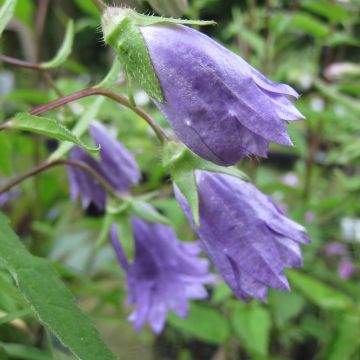
Comments